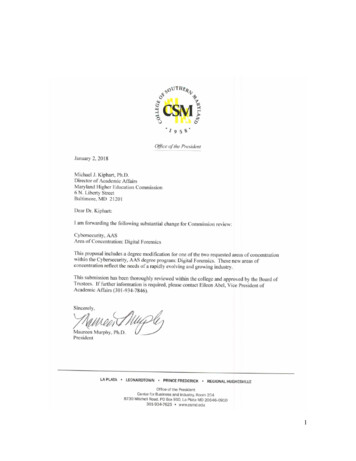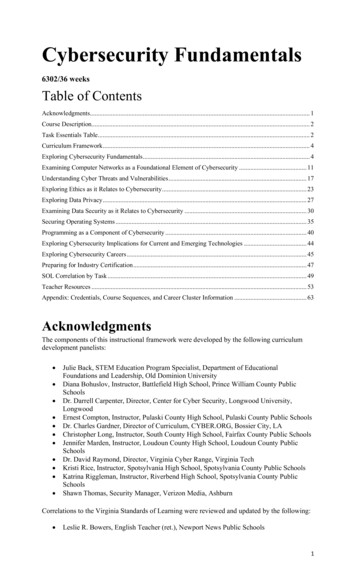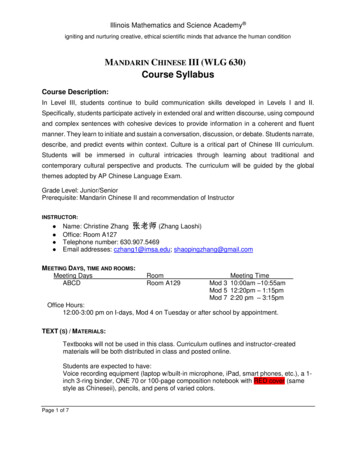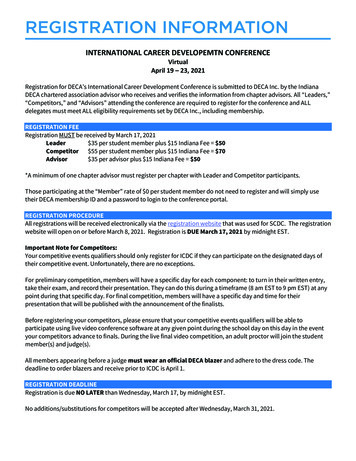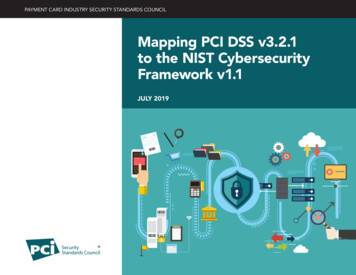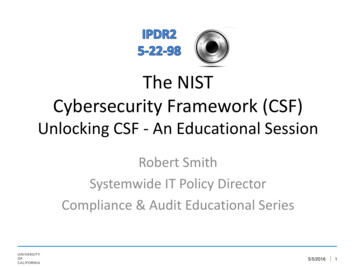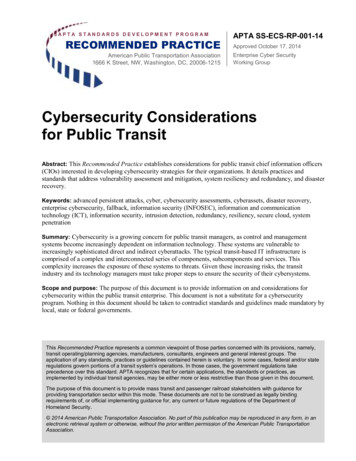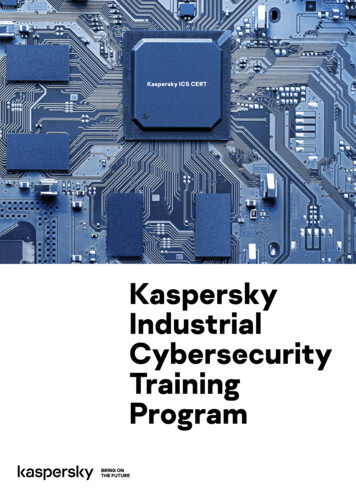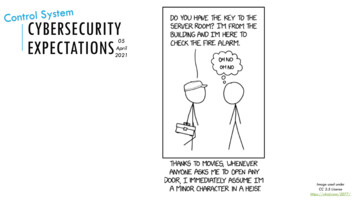
Transcription
CYBERSECURITYEXPECTATIONS05April2021Image used underCC 2.5 Licensehttps://xkcd.com/2077/
THIS TALK IS NOT ABOUT:1. CMMC(Cybersecurity Maturity Model Certification)2. RMF (Risk Management Framework)3. Justifying the need for cybersecurity
CMMC “How equipped are you to protect the government’s data?” By 2026 all DoD contractors will need a CMMC certification Only select ‘pilot’ contracts until 2026 Exception for COTS-only providers, but that’s likely not you! Does not replace the existing DFARS .7012 requirement Level depends on CUI (Controlled Unclassified Information) Level 1: You do not handle CUI, Level 3: You handle CUI
CMMC CONTINUED CUI Includes Things Like Information on the Physical Security of DoD assets Information on Vulnerabilities of Information Systems Personal Examples: Drawings of security plans, Electronic Security System designs ACAS Vulnerability Scan Results Network Device Configuration Files This is a contracting/acquisition requirement Talk to a Contracting Officer or check out YouTube!
RMF
JUSTIFYING THE NEED FOR CYBERSECURITY2021 – Verkada Surveillance Cameras & Access Control2021 – Florida Water Plant Hack2020 – SolarWinds Hack2020 - 50,000 IP-based surveillance cameras hacked2019 – First US electrical utility disrupted by cyberattack2016 – Ukraine power devices hack: 60 substations (Russia)2018 – Saipem (Italian oil) crippled by cyberattack2015 – Ukraine power operators PC: 250k customers(Russia)2015 – Turkey electrical distribution (Iran suspected)2014 – Wastewater plant, Alliant Healthcare, Sony2013 – Bowman Dam (NY) Hack
THIS TALK IS ABOUT:1. Goals of Cybersecurity in DoD Construction2. DoD Cybersecurity Construction Guidelines Design Requirements and Expectations Key Construction Submittals
GOALS IN DOD DESIGN/CONSTRUCTION:#1: Meet the functional requirements. Tailor cybersecurity requirements to the project. Example: If the customer doesn’t need a redundant system, thecybersecurity controls shouldn’t prescribe one. Keep it simple. If you can meet the requirements without a “smart system”, do so. We can’t afford to secure and continuously monitor unnecessary systems.
GOALS IN DOD DESIGN/CONSTRUCTION:#2: Provide a secured/hardened system. Goal IS NOT to get an ATO (Authority to Operate) Goal IS to provide a secured system with supportingdocumentation so that the system is technically capable ofreceiving an ATO without the need for reconfiguration.
DOD CYBERSECURITY CONSTRUCTION GUIDELINESUFC 4-010-06 & UFGS 25 05 11 UFC: Cybersecurity of Facility-Related Control Systems Revision likely released in Summer 2021. Minimize Network Dependency Reduce Extraneous Functionality Design for Graceful Failure No Remote Access! UFGS: Must be tailored to the system! Revision anticipated to be released in May 2021.
DESIGN REQUIREMENTS & EXPECTATIONSStep 1: Determine the System’s Impact Rating [Categorization]Cybersecurity: Practices designed to protect the confidentiality,integrity, and availability of information systems and data.C-I-A (aka “Impact Rating”)L-M-H (Low – Moderate – High)
DESIGN REQUIREMENTS & EXPECTATIONSStep 1: Determine the System’s Impact Rating [Categorization] This is the customer’s responsibility! Ideally, this is defined during the 1391 development unfortunately, we’re not there yet. If a rating is not provided [for each system], submit an RFI. If they fail to respond, document that in the Design Analysis (DA) and make an assumption. Assumption may be based on the “FRCS Master List”, similar past projects, or guidance from the MCX. Each system’s impact rating and how it was obtained should be documented in the DA.If you’re modifying, or connecting to, an existing system, there is a [small, but growing] chancethat an ATO exists for that system. If so, then there will be an already approved Impact Ratingand baseline CCIs. It should also define how changes are to be made to the system.
DESIGN REQUIREMENTS & EXPECTATIONSStep 2: Generate the list of potentially applicable controls. You could start with the Controls (UFC 4-010-06, Appendix G) Often simpler to jump to the CCIs (Control Correlation Identifiers) UFC 4-010-06, Appendix H tells you which CCIs do, or do not, apply to Control Systems. Also tells you which CCIs are, or are not, the designer’s responsibility. Also tells you at what impact level specific CCIs apply to (LOW or MODERATE). After filtering these down, this is your baseline CCI set. SAVE THESE BASELINES AS STARTING POINTS FOR OTHER SIMILAR PROJECTS!
DESIGN REQUIREMENTS & EXPECTATIONSStep 3: Start tailoring the applicable CCIs. At 35% you might not know everything, but use what you know: A hard requirement for a workstation will drive many ‘Applicable’ CCIs A basic Fire Alarm Panel will have relatively few Continue to tailor this list as the design progresses. Maintain close communications with the other disciplines
DESIGN REQUIREMENTS & EXPECTATIONSStep 3: Start tailoring the applicable CCIs.CCIControl Text (Summarized)Fire Alarm PanelFull BAS w/PCCCI-000399Produce an InventoryApplicableApplicableCCI-000200Passwords can’t be reused for at least 5 generations.ImpracticalApplicableCCI-001989Change Default CredentialsApplicableApplicableCCI-001441Maintain Audit Trail on Wireless AccessN/A*N/A*
DESIGN REQUIREMENTS & EXPECTATIONSStep 4: Start tailoring the 25 05 11 specification. Every paragraph in the 25 05 11 is tied to one or more CCIs Eliminate the paragraphs for ‘N/A’ or ‘Impractical’ CCIs Include any site or system-specific requirements. Ex. An existing ATO’s Configuration Management requirements Ex. The office/department responsible for issuing IP addresses.
DESIGN REQUIREMENTS & EXPECTATIONSWhat are you really looking for?
DESIGN REQUIREMENTS & EXPECTATIONSConcept Design Expectations (10-35%) Separate Cybersecurity chapter in the DA Provide functional description/narrative of each system, plus: System’s impact rating and how it was determined. Interconnection requirements and responsibilities. Any existing ATOs and/or specific Configuration Management requirements Preliminary CCI lists based on the impact rating and known system attributes Provide a High-Level/Notional Diagram* *Not technically required by the UFC yet but UFGS: Table of Contents One 25 05 11 entry for each control system* Significantly similar systems may be combined
DESIGN REQUIREMENTS & EXPECTATIONSDesign Development Expectations (50-65%) Updated DA that is consistent across disciplines and drawings CCI lists are relatively finalized and properly annotated. (Each CCI either indicated as incorporated into the design, or a reason given for its exclusion.) Any basis-of-design cut sheets provided align with the cybersecurity approach. (Don’t include a cut sheet for an Air Compressor that comes standard with an integrated webserver!) Draft 25 05 11 specification for each system 25 05 11 is generally tailored to the specific control system (in accordance with CCIs) There are no inconsistencies between the 25 05 11 and other specs/drawings
DESIGN REQUIREMENTS & EXPECTATIONSPre-Final Design Expectations (90-95%) Each 25 05 11 is complete and fully tailored to each system. The CCIs are finalized and fully incorporated into the specs “N/A” or “Impractical” CCIs have been removed from the specs No inconsistencies between spec sections No inconsistencies between the 25 05 11 and the drawings
CONSTRUCTION REQUIREMENTSThere’s a 25 05 11; what do I do with it? The intent of the 25 05 11 was to eliminate the need for a cybersecurity SME.However The specification relies heavily on “STIG/SRGs” Throws out terms like “Vulnerability Scanning” Specific devices are not often known at time of design
KEY 25 05 11 SUBMITTALSSD-01 Pre-Construction Contractor Cybersecurity Compliance Statements Cybersecurity Subject Matter Expert Qualifications*SD-02 Shop Drawings Network Communication Report (Ports & Protocols) Cybersecurity Riser Diagram Control System Inventory Report Cybersecurity Interconnection Schedule Proposed STIG/SRGs*
KEY 25 05 11 SUBMITTALSSD-03 Product Data Control System Cybersecurity Documentation Technical Manual (user roles, permission matrix, security options) Vendor Secure Configuration/Installation Guides Known vulnerabilities (vendor releases, ICS-CERT, NIST NVD)SD-11 Closeout Submittals Password Summary Report Software Recovery and Reconstitution Images (Backups) Completed STIG/SRG Checklists* Completed Vulnerability Scans*
ANTICIPATED REVISIONS TO UFGS 25 05 11 Software disabling of Wireless is not sufficient, must be physical. Defining customer POCs in the specs (improved coordination). New submittals: Proposed STIG/SRGs, Test Procedures, Maintenance ToolSoftware, Scanning Tools, Information at Rest, Integrity Verification,Software/Configuration Backups Additional spec tailoring options: Controllers, Lighting Control, ESS, Fire Protection Support for MODERATE systems.
/TALK Cybersecurity requirements depend on the specific system.Cybersecurity is not just technical controls.
2016 –Ukraine power devices hack: 60 substations (Russia) 2018 –Saipem (Italian oil) crippled by cyberattack . You could start with the Controls (UFC 4-010-06, Appendix G) Often simpler to jump to the CCIs (Control Correlation Identifiers) UFC 4-010-06, Appendix H tells yo
